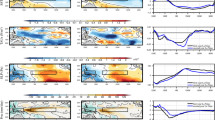Abstract
Daily rainfall variability over southern Africa (SA) and the southwest Indian Ocean (SWIO) during the austral summer months has recently been described objectively for the first time, using newly derived satellite products. The principle mode of variability in all months is a dipole structure with bands of rainfall orientated northwest to southeast across the region. These represent the location of cloud bands associated with tropical temperate troughs (TTT). This study objectively identifies major TTT events during November to February, and on the basis of composites off NCEP reanalysis data describes the associated atmospheric structure. The two phases of the rainfall dipole are associated with markedly contrasting circulation patterns. There are also pronounced intra-seasonal variations. In early summer the position of the temperate trough and TTT cloud band alternates between the SWIO and southwest Atlantic. In late summer the major TTT axis lies preferentially over the SWIO, associated with an eastward displacement in the Indian Ocean high. In all months, positive events, in which the TTT cloud band lies primarily over the SWIO, are associated with large-scale moisture flux anomalies, in which convergent fluxes form a pronounced poleward flux along the cloud band. This suggests that TTT events are a major mechanism of poleward transfer of energy and momentum. Moisture transport occurs along three principle paths: (1) the northern or central Indian Ocean (where anomalous fluxes extend eastward to the Maritime Continent), (2) south equatorial Africa and the equatorial Atlantic, (3) from the south within a cyclonic flow around the tropical-temperate trough. The relative importance of (2) is greatest in late summer. Thus, synoptic scale TTT events over SA/SWIO often result from large-scale planetary circulation patterns. Hovmoeller plots show that TTT development coincides with enhanced tropical convection between 10°–30°E (itself exhibiting periodicity of around 5 days), and often with convergence of eastward and westward propagating convection around 40°E. Harmonic analysis of 200 hPa geopotential anomalies show that TTT features are forced by a specific zonally asymmetric wave pattern, with wave 5 dominant or significant in all months except February when quasi-stationary waves 1, 2 and 3 dominate. These findings illustrate the importance of tropical and extratropical dynamics in understanding TTT events. Finally, it is suggested that in November–Januar TTT rainfall over SA/SWIO may be in phase with similar rainfall dipole structures observed in the South Pacific and South Atlantic convergence zones.
Similar content being viewed by others
Author information
Authors and Affiliations
Additional information
Received: 11 August 1998 / Accepted: 28 May 1999
Rights and permissions
About this article
Cite this article
Todd, M., Washington, R. Circulation anomalies associated with tropical-temperate troughs in southern Africa and the south west Indian Ocean. Climate Dynamics 15, 937–951 (1999). https://doi.org/10.1007/s003820050323
Issue Date:
DOI: https://doi.org/10.1007/s003820050323




